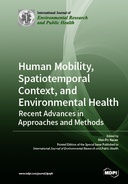Explore

Human Mobility, Spatiotemporal Context, and Environmental Health: Recent Advances in Approaches and Methods
Mei-Po Kwan
2019
0 Ungluers have
Faved this Work
Login to Fave
Environmental health researchers have long used concepts like the neighborhood effect to assessing people’s exposure to environmental influences and the associated health impact. However, these are static notions that ignore people’s daily mobility at various spatial and temporal scales (e.g., daily travel, migratory movements, and movements over the life course) and the influence of neighborhood contexts outside their residential neighborhoods. Recent studies have started to incorporate human mobility, non-residential neighborhoods, and the temporality of exposures through collecting and using data from GPS, accelerometers, mobile phones, various types of sensors, and social media. Innovative approaches and methods have been developed. This Special Issue aims to showcase studies that use new approaches, methods, and data to examine the role of human mobility and non-residential contexts on human health behaviors and outcomes. It includes 21 articles that cover a wide range of topics, including individual exposure to air pollution, exposure and access to green spaces, spatial access to healthcare services, environmental influences on physical activity, food environmental and diet behavior, exposure to noise and its impact on mental health, and broader methodological issues such as the uncertain geographic context problem (UGCoP) and the neighborhood effect averaging problem (NEAP). This collection will be a valuable reference for scholars and students interested in recent advances in the concepts and methods in environmental health and health geography.
This book is included in DOAB.
Why read this book? Have your say.
You must be logged in to comment.
Rights Information
Are you the author or publisher of this work? If so, you can claim it as yours by registering as an Unglue.it rights holder.Downloads
This work has been downloaded 476 times via unglue.it ebook links.
- 72 - pdf (CC BY-NC-ND) at Unglue.it.
Keywords
- 2009 influenza A(H1N1) pandemic
- 3SFCA
- access probability
- active travel
- activity space
- adults
- ageing
- air pollution exposure
- Beijing
- big data
- bike paths
- Brazil
- built environment
- car ownership
- car use
- Catchment Areas
- CHAS
- China
- Cognitive Aging
- collective leisure activity
- commuting route
- correlation analysis
- crop residue burning
- crowdedness
- cycling for transportation
- dynamic assessment
- E2SFCA
- ecological momentary assessment
- EMA
- emissions estimation
- environmental context cube
- environmental context exposure index
- environmental exposure
- environmental exposures
- Environmental health
- food environment
- foodscape exposure
- fuel consumption
- geographic impedance
- geographic imputation
- geographical accessibility
- GIS
- GPS
- GPS trace
- green space
- greenspace exposure
- Guangzhou
- Health
- healthcare accessibility
- Healthcare services
- human mobility
- Imputation
- interannual and seasonal variations
- life-course perspectives
- long-distance walking
- medicine
- Mental Disorders
- missing data
- mobile phone data
- multilevel Bayesian model
- multilevel model
- multimodal network
- noise pollution
- Obesity
- personal projects
- physical activity
- physical environment
- PM concentrations
- population demand
- primary healthcare
- Public Participatory GIS (PPGIS)
- quantile regression
- rail travel
- real-time traffic
- Regression analysis
- road traffic accidents
- Singapore
- space-time kernel density estimation
- spatial accessibility
- spatial autocorrelation
- Spatial data
- spatial spread
- Structural Equation Modeling
- subway stations
- taxi GPS trajectories
- the elderly
- the neighborhood effect averaging problem (NEAP)
- the uncertain geographic context problem
- the uncertain geographic context problem (UGCoP)
- time-weighted exposure
- train stations
- transport modes
- UGCoP
- urban leisure
- urban planning
- Walking
- walking event
- well-being experience
Links
DOI: 10.3390/books978-3-03921-184-5Editions


